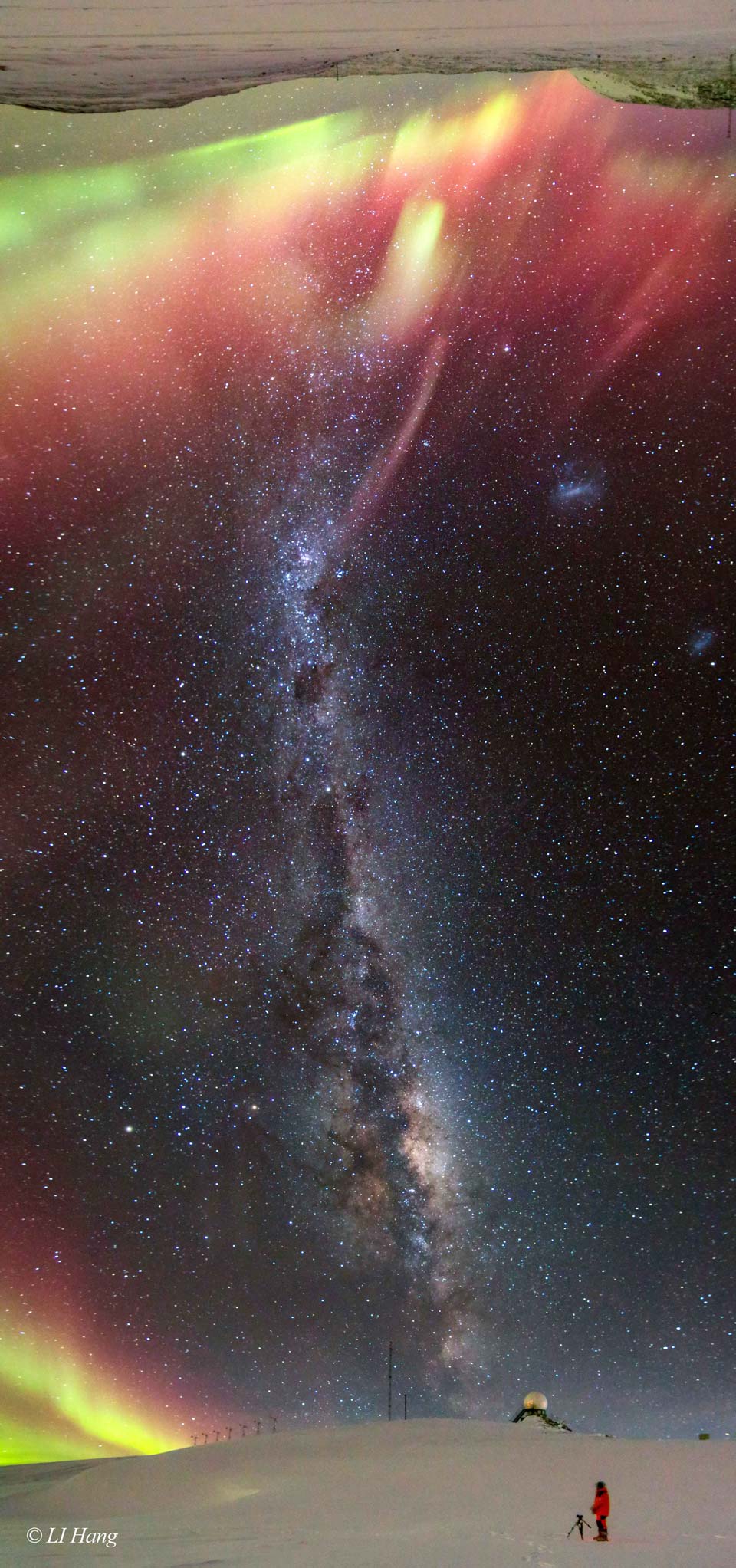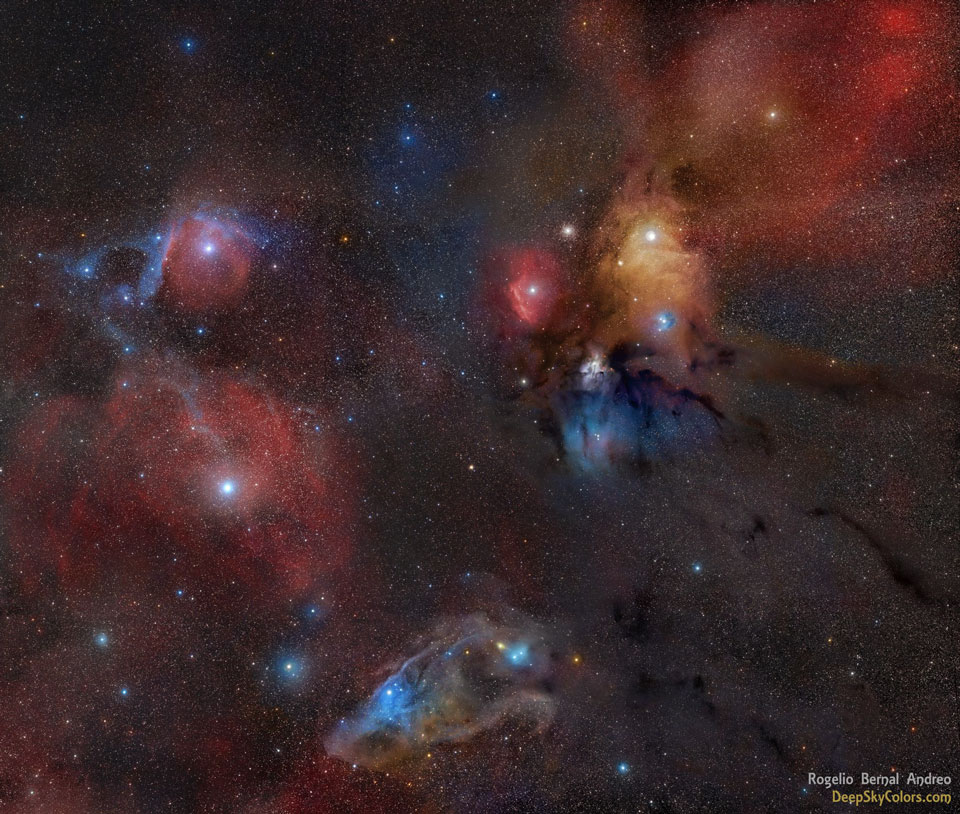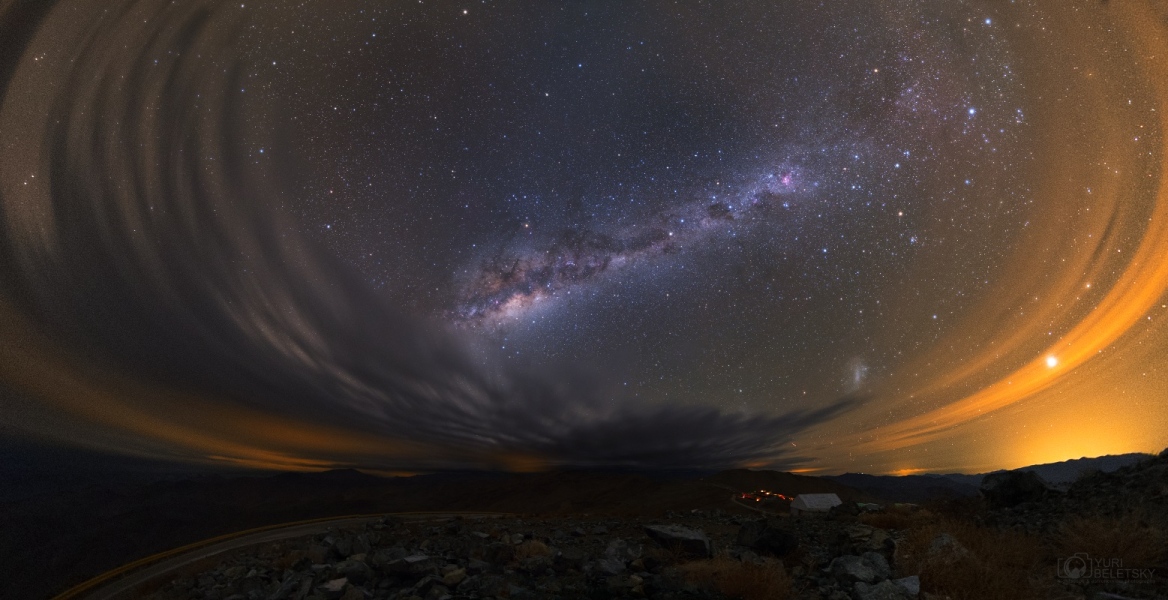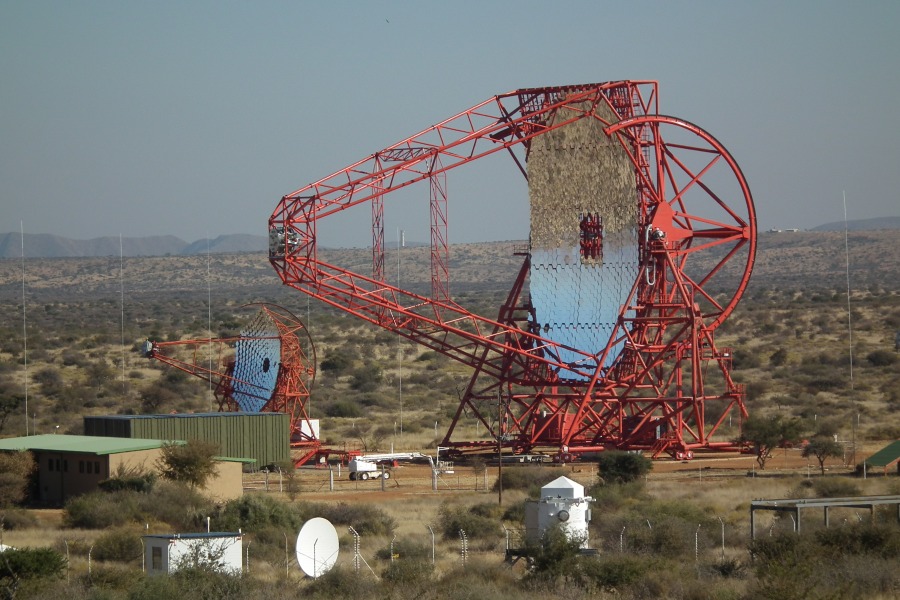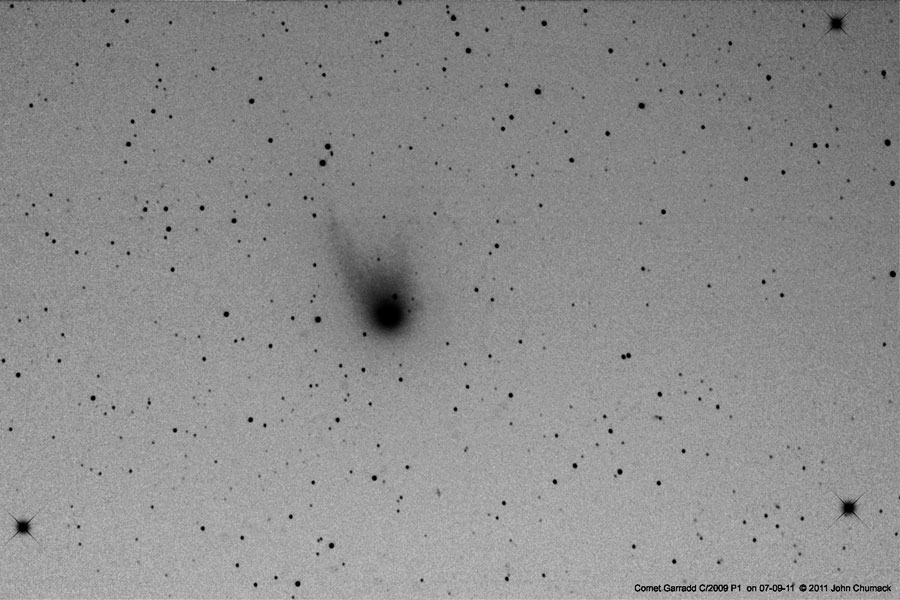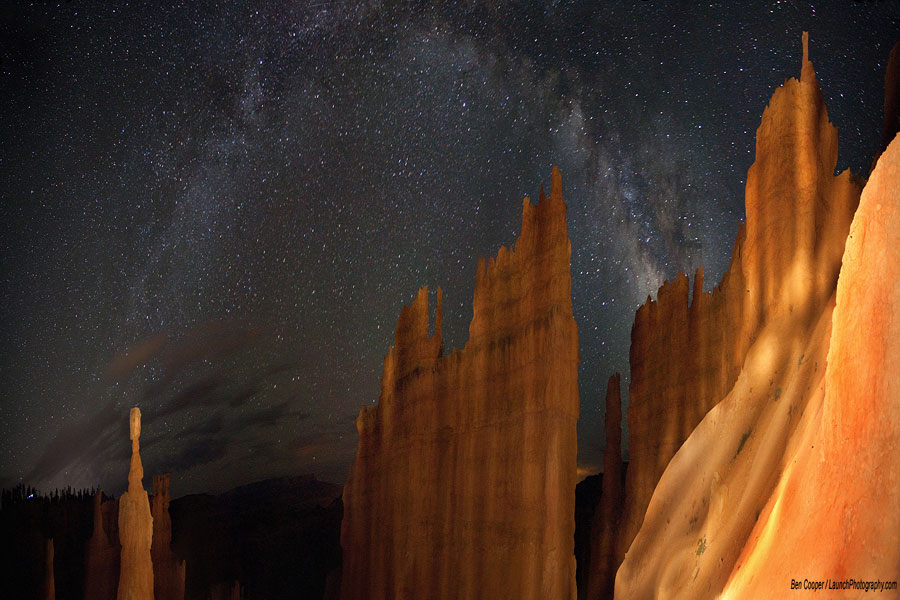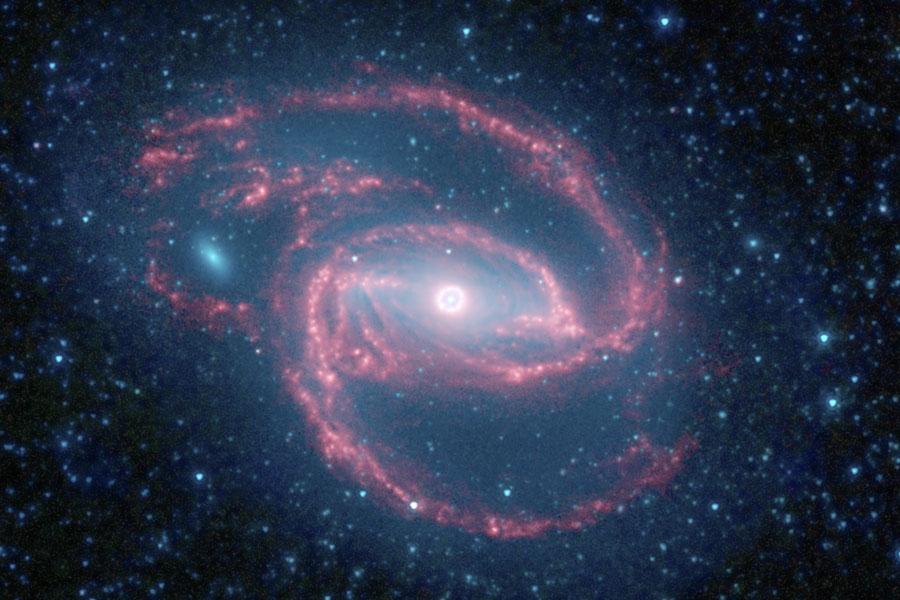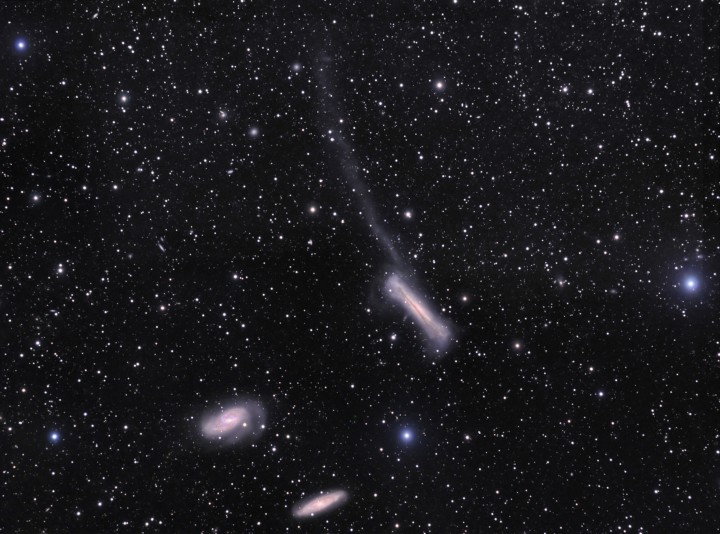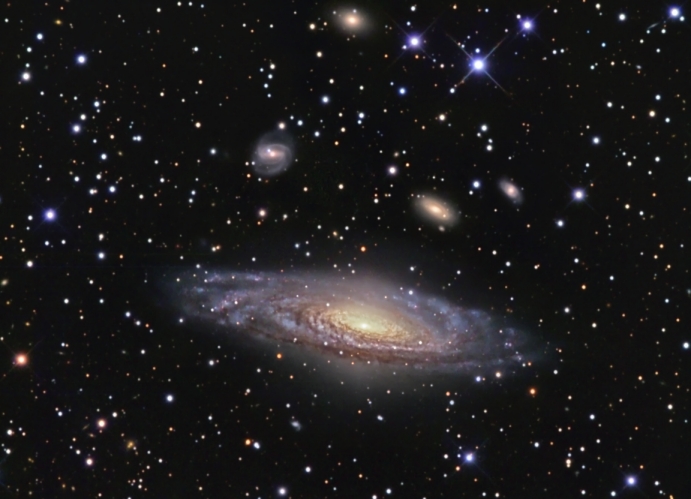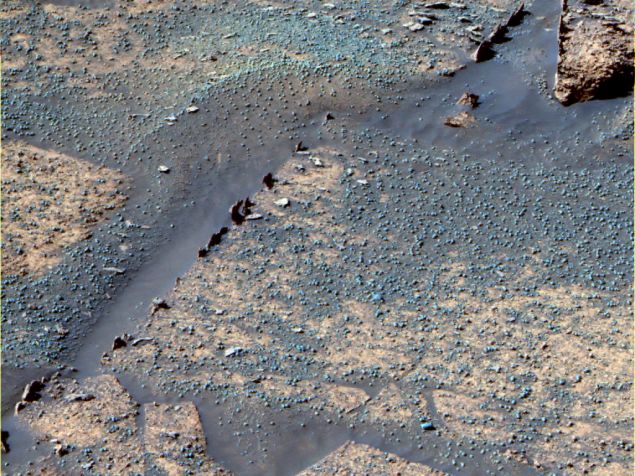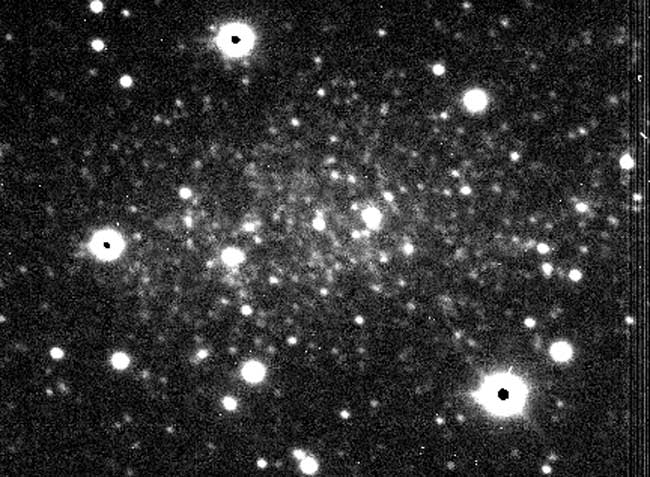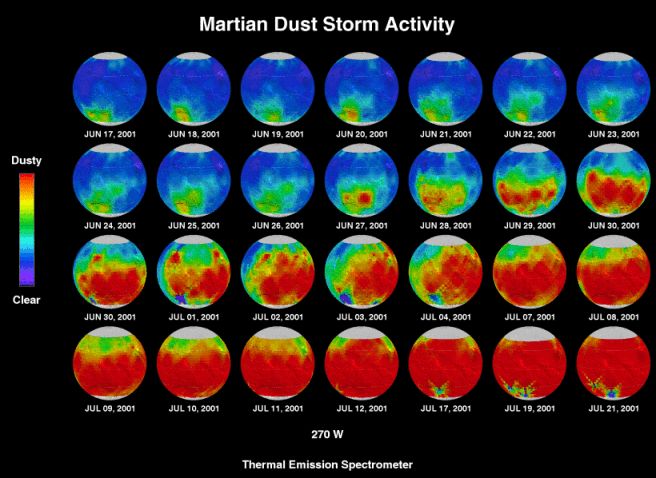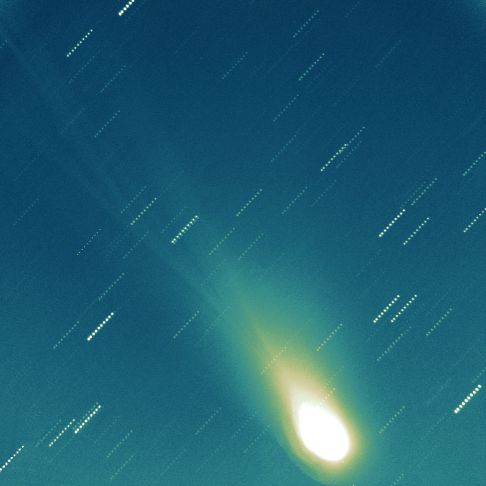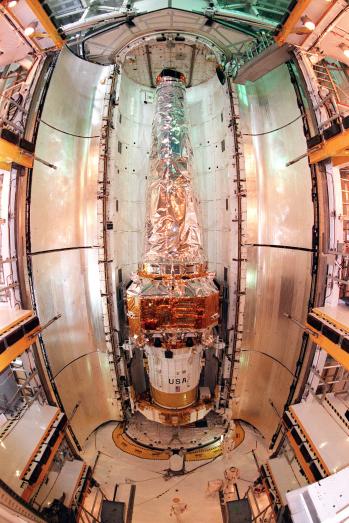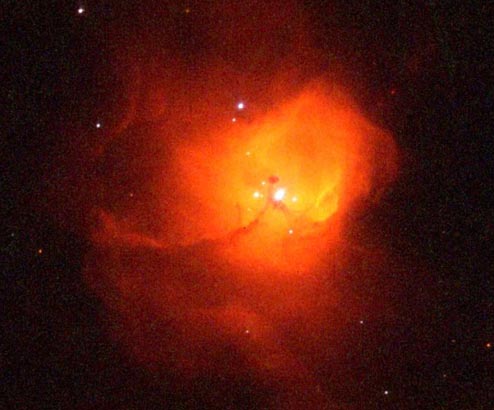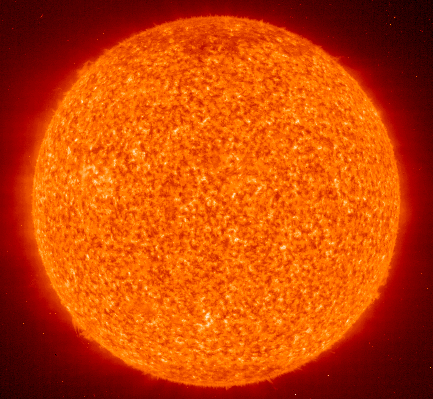| << Previous | Index | Next >> |
2015 It has been one of the better skies of this long night. In parts of Antarctica, not only is it winter, but the Sun can spend weeks below the horizon. At China's Zhongshan Station, people sometimes venture out into the cold to photograph a spectacular night sky. The featured image from one such outing was taken in mid-July, just before the end of this polar night. Pointing up, the wide angle lens captured not only the ground at the bottom, but at the top as well. In the foreground is a colleague also taking pictures. In the distance, a spherical satellite receiver and several windmills are visible. Numerous stars dot the night sky, including Sirius and Canopus. Far in the background, stretching overhead from horizon to horizon, is the central band of our Milky Way Galaxy. Even further in the distance, visible as extended smudges near the top, are the Large and Small Magellanic Clouds, satellite galaxies near our huge Milky Way Galaxy.
2014 The clouds surrounding the star system Rho Ophiuchi compose one of the closest star forming regions. Rho Ophiuchi itself is a binary star system visible in the light-colored region on the image right. The star system, located only 400 light years away, is distinguished by its colorful surroundings, which include a red emission nebula and numerous light and dark brown dust lanes. Near the upper right of the Rho Ophiuchi molecular cloud system is the yellow star Antares, while a distant but coincidently-superposed globular cluster of stars, M4, is visible between Antares and the red emission nebula. Near the image bottom lies IC 4592, the Blue Horsehead nebula. The blue glow that surrounds the Blue Horsehead's eye -- and other stars around the image -- is a reflection nebula composed of fine dust. On the above image left is a geometrically angled reflection nebula cataloged as Sharpless 1. Here, the bright star near the dust vortex creates the light of surrounding reflection nebula. Although most of these features are visible through a small telescope pointed toward the constellations of Ophiuchus, Scorpius, and Sagittarius, the only way to see the intricate details of the dust swirls, as featured above, is to use a long exposure camera.
2013 Storm clouds do sometimes come to Chile's Atacama desert, known as the driest place on Earth. These washed through the night sky just last month during the winter season, captured in this panoramic view. Drifting between are cosmic clouds more welcome by the region's astronomical residents though, including dark dust clouds in silhouette against the crowded starfields and nebulae of the central Milky Way. Below and right of center lies the Large Magellanic Cloud, appropriately named for its appearance in starry southern skies. City lights about 200 kilometers distant still glow along the horizon at the right, while bright star Canopus shines above them in the cloudy sky.
2012 The largest of its kind, the High Energy Stereoscopic System (H.E.S.S.) II telescope stands in the foreground of this photo. Tilted horizontally it reflects the inverted landscape of the Namibian desert in a segmented mirror 24 meters wide and 32 meters tall, equal in area to two tennis courts. Now beginning an exploration of the Universe at extreme energies, H.E.S.S. II saw first light on July 26. Most ground-based telescopes with lenses and mirrors are hindered by the Earth's nurturing, protective atmosphere that blurs images and scatters and absorbs light. But the H.E.S.S. II telescope is a cherenkov telescope, designed to detect gamma rays - photons with over 100 billion times the energy of visible light - and actually requires the atmosphere to operate. As the gamma rays impact the upper atmosphere they produce air showers of high-energy particles. A large camera at the mirror's focus records in detail the brief flashes of optical light, called cherenkov light, created by the air shower particles. The H.E.S.S. II telescope operates in concert with the array of four other 12 meter cherenkov telescopes to provide multiple stereoscopic views of the air showers, relating them to the energies and directions of the incoming cosmic gamma rays.
2011 Another large snowball is falling toward the Sun. Comet Garradd was discovered two years ago by Gordon Garradd in Australia, and is currently visible through a small telescope at visual magnitude nine. Officially designated C/2009 P1 (Garradd), the comet will likely continue to brighten, with recent projections placing it at peak magnitude six or seven in February 2012, just below naked eye visibility. Comet Garradd is already showing a short tail and is seen as the elongated fuzzy patch in the above negative image recorded earlier this month from Yellow Springs, Ohio, USA. Other comets are also currently falling into the inner Solar System and brightening as well, including C/2010 X1 (Elenin), expected to peak near magnitude six in early September, 45P/Honda-Mrkos-Pajdusakova expected to peak brighten past magnitude eight in mid-August, and C/2011 L4 (PANSTARRS) which may become visible to the unaided eye during the early months of 2013.
2010 What are those strange rock structures? They are towers and walls of sedimentary rock that are particularly plentiful in Bryce Canyon in Utah, USA. The rock columns may rise higher than 50 meters and are called hoodoos. On the far left is Thor's Hammer, perhaps the most famous hoodoo. The tall rock columns were carved, most typically, when a unusually dense cap of rock provided a layer of protection to rock underneath from rain-based erosion. In the above panoramic picture taken earlier this month and compressed horizontally, the foreground rocks were momentarily illuminated by a roving spotlight. Visible in the background are a few water clouds a few kilometers away hovering over the nearby Earth. Visible well beyond that are thousands of individually discernible stars averaging a few hundred light years away in the nearby Milky Way Galaxy. Far in the distance lie billions of stars that are thousands of light years away and compose the faintly glowing arch that is the visible central band of the flat disk of our Milky Way. Over many years, wind and rain will eventually cause the tops of the hoodoos to topple, whereafter the underlying column will likely completely erode away.
2009 What's happening at the center of spiral galaxy NGC 1097? No one is sure, but it likely involves a supermassive black hole. Matter falling in from a bar of stars and gas across the center is likely being heated by an extremely energetic region surrounding the central black hole. From afar, the entire central region appears in the above false-color infrared image as a mysterious eye. Near the left edge and seen in blue, a smaller companion galaxy is wrapped in the spectacular spiral arms of the large spiral, lit in pink by glowing dust. Currently about 40 thousand light-years from the larger galaxy's center, the gravity of the companion galaxy appears to be reshaping the larger galaxy as it is slowly being destroyed itself. NGC 1097 is located about 50 million light years away toward the constellation of the furnace (Fornax).
2008 How can a round star make a square nebula? This conundrum comes to light when studying planetary nebulae like IC 4406. Evidence indicates that IC 4406 is likely a hollow cylinder, with its square appearance the result of our vantage point in viewing the cylinder from the side. Were IC 4406 viewed from the top, it would likely look similar to the Ring Nebula. This representative-color picture is a composite made by combining images taken by the Hubble Space Telescope in 2001 and 2002. Hot gas flows out the ends of the cylinder, while filaments of dark dust and molecular gas lace the bounding walls. The star primarily responsible for this interstellar sculpture can be found in the planetary nebula's center. In a few million years, the only thing left visible in IC 4406 will be a fading white dwarf star.
2007 A mere 30 million light-years away, large spiral galaxy NGC 3628 (center) shares its neighborhood in the local Universe with two other large spirals, in a magnificent grouping otherwise known as the Leo Triplett. In fact, fellow trio member M65 is near the bottom edge of this deep cosmic group portrait, with M66, just above it and to the left. But, perhaps most intriguing is the spectacular tail stretching up and to the left for about 300,000 light-years from NGC 3628's warped, edge-on disk. Know as a tidal tail, the structure has been drawn out of the galaxy by gravitational tides during brief but violent past interactions with its large neighbors. Not often imaged so distinctly, the tidal tail is composed of young bluish star clusters and star-forming regions.
2006 Spiral galaxy NGC 7331 is often touted as an analog to our own Milky Way. About 50 million light-years distant in the northern constellation Pegasus, NGC 7331 was recognized early on as a spiral nebula and is actually one of the brighter galaxies not included in Charles Messier's famous 18th century catalog. Since the galaxy's disk is inclined to our line-of-sight, long telescopic exposures often result in an image that evokes a strong sense of depth. The effect is further enhanced in this well-framed view by the galaxies that lie beyond this beautiful island universe. The background galaxies are about one tenth the apparent size of NGC 7331 and so lie roughly ten times farther away.
2005 NASA's launch of the massive Space Shuttle Discovery yesterday brought a nation known for its tremendous space program back to human space flight. Shuttle flights had been suspended for over two years previously following the tragic loss of the Space Shuttle Columbia crew on 2003 February 1. The complex, powerful Space Shuttle Discovery lifted a crew of seven into an Earth orbit that will bring them to the International Space Station (ISS). The shuttle crew will deliver supplies to the ISS, perform repairs, and test new methods for inspecting and repairing the shuttle's thermal protection system. Three space walks are planned. This Return to Flight Mission STS-114 is pictured above launching from Pad 39B on Cape Canaveral, Florida.
2004 Over one year after its launch, robot geologist Opportunity has been spending recent sols on Mars inching its way down the slopes of Endurance crater. Littered with martian blueberries, some flat rocks within the crater also seem to have surprising razorbacks -- narrow slabs sticking up along their edges. Like the blueberries, it's possible that the sharp, narrow features are related to water. They could be formed by minerals deposited by water in cracks, with the surrounding softer material subsequently eroded away. How narrow are they? The ones pictured here in an enhanced color image from Opportunity's panoramic camera are actually only a few centimeters high and about half a centimeter wide. Impressive 3D views have been constructed by stereo experimenter P. Vantuyne based on the camera's left and right eye images of the region.
2003 Our Milky Way Galaxy is not alone. It is part of a gathering of about 50 galaxies known as the Local Group. Members include the Great Andromeda Galaxy (M31), M32, M33, the Large Magellanic Cloud, the Small Magellanic Cloud, Dwingeloo 1, several small irregular galaxies, and many dwarf elliptical and dwarf spheroidal galaxies. Pictured above is the Aquarius Dwarf, a faint dwarf irregular galaxy over 3 million light years away. An earlier APOD erroneously identified the above image as the Sagittarius Dwarf.
2002 Bright sunlight glints and long dark shadows dramatize this image of the lunar surface taken by Apollo 11 astronaut Neil Armstrong, the first to walk on the Moon. Pictured is the mission's lunar module, the Eagle, and spacesuited lunar module pilot Buzz Aldrin unfurling a long sheet of foil also known as the Solar Wind Collector. Exposed facing the Sun, the foil trapped atoms streaming outward in the solar wind, ultimately catching a sample of material from the Sun itself. Along with moon rocks and lunar soil samples, the solar wind collector was returned for analysis in earthbound laboratories.
2001 If you've been unhappy with the weather on Earth, check out Mars, now in the grip of a planet-wide dust storm. Above, observations from the orbiting Mars Global Surveyor (MGS) spacecraft illustrate the storm's progress through July 21. The series of dated frames show measurements from the MGS Thermal Emission Spectrometer which can determine both temperature and amount of atmospheric dust. Dust data has been plotted on maps of the martian surface with blue representing relatively clear atmosphere and red colors indicating increasing concentrations of dust. In mid June, scientists first noticed the beginnings of the storm in Mars' southern hemisphere and have watched it grow to obscure most of the planet. Unfortunately for Mars-watchers, the timing of the storm has hidden the Red Planet's surface from view during its period of close approach to planet Earth.
2000 Comet C/1999 S4 LINEAR is only one of many comets discovered with the Lincoln Near Earth Asteroid Research (LINEAR) telescope operating near Soccoro, New Mexico, USA. Traveling steadily southward through Earth's night sky, C/1999 S4 passed perihelion (closest approach to the Sun) yesterday on what is likely its first trip through the inner solar system. Now fading, comet LINEAR became no brighter than about 6th magnitude, but is still easily visible with binoculars in northern hemisphere skies. While the memorable comets Hale-Bopp and Hyakutake were much brighter, comet LINEAR is displaying delightful tails evident in this false-color composite image from the Crni Vrh Observatory in Slovenia. The combined series of exposures made on July 22nd are registered on the comet. In the resulting picture, stars appear as rows of dots, but the faint structures in the comet's tail are beautifully recorded. Presently seen moving from Ursa Major to Leo this comet LINEAR will begin to shine in southern hemisphere skies in August.
1999 Wrapped in protective blankets and mounted atop an Inertial Upper Stage (IUS) rocket, the Chandra X-ray Telescope is seen in this wide-angle view before launch snuggled into the space shuttle Columbia's payload bay. Columbia's crew released the telescope, named in honor of the late Nobel Laureate Subrahmanyan Chandrasekhar, into orbit on Friday, July 23rd, where it is now undergoing check out and activation of its scientific instruments. To help realize its enormous potential for exploration of the distant Universe at X-ray energies, controllers will perform a series of firings in the coming days which will eventually boost the 10,000 pound telescope into a highly ecentric orbit. In fact, the final working orbit for Chandra will range from a close point of about 6,200 miles out to 87,000 miles or one third of the distance to the Moon. The elongated orbit will carry Chandra's sensitive X-ray detectors beyond interference caused by the Earth's radiation belts allowing Chandra to make about 55 hours of continuous observations per orbit. The shuttle Colombia, commanded by Eileen Collins is scheduled to land this evening at 11:20 pm EDT at Kennedy Space Center.
1998 A very young star cluster has been discovered in a neighboring galaxy. The stars found in this cluster, dubbed N81, are so young and massive that they furiously eject matter and light up the surrounding nebula. The ejected stellar winds combine and interact to sculpt beautiful and complex structures. Visible near the center of the above representative-color picture are two of N81's brightest stars. Just above them lies a dark knot of dust and gas where these massive stars probably originated. The home galaxy of this stellar nursery is the Small Magellanic Cloud (SMC) located about 200,000 light-years away.
1997 Pictured above is one of the world's premiere radio astronomical observatories: The Very Large Array (VLA). Each antenna dish is as big as a house (25 meters across) and mounted on railroad tracks. The VLA consists of 27 dishes - together capable of spanning the size of a city (35 kilometers). The VLA is the most sensitive radio telescope ever, and, through interferometry, can resolve a golf ball-sized radio source 150 kilometers away (0.04 arcsec). The VLA is continually making new discoveries, including determining the composition of galaxies, passing comets, quasars, HII regions, and clusters of galaxies. The VLA is also used to receive the weak radio signals broadcast from interplanetary spacecraft. The VLA is located in New Mexico, USA. A significant upgrade of VLA's capabilities is planned.
1996 How long would it take to drive to the Sun? Brittany, age 7, and D.J., age 12, ponder this question over dinner one evening. James, also age 7, suggests taking a really fast racing car while Christopher, age 4, eagerly agrees. Jerry, a really old guy who is used to estimating driving time on family trips based on distance divided by speed, offers to do the numbers. "Let's see ... the Sun is 93 million miles away. So, if we drove 93 miles per hour the trip would only take us 1 million hours." How long is 1 million hours? One year is 365 days times 24 hours per day, or 8,760 hours. One hundred years would be 876,000 hours, still a little short of the 1 million hour drive time -- so the Sun is really quite far away. Christopher is not impressed, but as he grows older he will be. You've got to be impressed by something that's 93 million miles away and still hurts your eyes when you look at it!
1995 A star with mass similar to that of our Sun will throw off its outer gasses after fusion has stopped in its core. Possibly the most visually spectacular of these planetary nebula is the pictured Ring Nebula. The appearance as a ring is really an illusion of projection - the nebula is actually a spherical shell. At the center a blue dot is visible which is the old core of the star, known as a white dwarf. It is still not known exactly how the star throws off the gas that becomes the nebula.
| << Previous | Index | Next >> |
